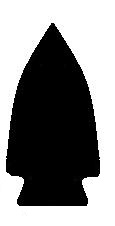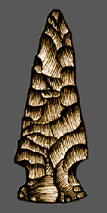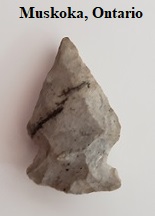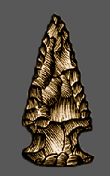Name Details:
Named By: Ian Kenyon
Named For: Saugeen Culture / Saugeen River
Date Identified: 1979
Type Site:
Saugeen
Cluster:
Commonly Utilized Material:
Local cherts are most preferred including Kettle Point chert
and Onondaga chert.
Date:
Cultural Period:
2,500 - 1,500 B.P.
Woodland
Roman Warm
Saugeen Culture
Glacial Period:
Culture:
Outline is Representative of Size and Shape:
Description of Physical Characteristics and Flaking Pattern:
This is a thick medium triangular expanding to side notch point with a
cross section that may vary from elliptical to having a diamond shape. The blade ranges from excurvate to straight in examples that are re-sharpened. The shoulders may range from horizontal to
having a slightly upward angle. The stem is expanding and may have a side notch
or expanding stem appearance. The base ranges from straight to
slightly convex. This point is commonly asymmetrical and crudely made
with irregular flaking and hinge fractures commonly present, forming a random
flaking pattern.
Size Measurements: Length: 40 to 60 mm, Width -
20 to 30 mm, Hafting Width - 15 to 22 mm, Thickness - 7 - 10 mm,
Width / Thickness Ratio - 3 to 4 to 1,
(Ontario Archaeological Society - London Chapter)
Distribution:
Distribution Comments:
This point is primarily found in the Lake Huron drainage system, most concentrated in the Saugeen, Maitland, and Ausable river valleys and to the shore line of Lake Erie.
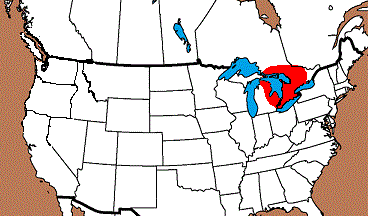
Related / Associated Points:
Additional Comments:
The London Chapter of the Ontario Archaeological Society notes that "In Michigan, the Middle Woodland levels of the
Schultz site have "large expanding stemmed points" (made from the local Bayport chert) which are very similar in both form and size to the Saugeen points. There are several Hopewellian types which are morphologically
similar to Saugeen points; namely Steuben Stemmed, Manker Stemmed and Manker Corner Notched. In Ontario these Hopewellian types are found occasionally; they can be distinguished from Saugeen points since the
Hopewellian forms are made from exotic cherts, especially Flint Ridge (Ohio)."
Other points in this Cluster:
Point Validity: Valid Type
Kenyon is an archaeologist and was instrumental in the formation of the London Chapter of
the Ontario Archeological Society and the development of the Kewa publication. He has specialized in the archaeology of Ontario. This type was named in a professional publication and has many professional
references. This is considered a valid type.
.
Age Details:
Pictures Provided By:
Ryan Fodfrey
References: (See Reference Page, Entry Number):
30, W14
Saugeen Projectile Point, Saugeen Arrowhead
